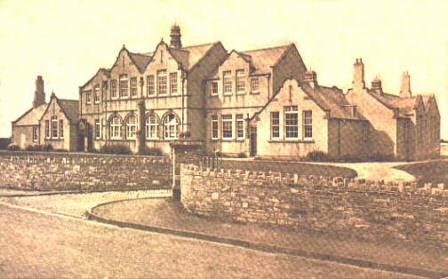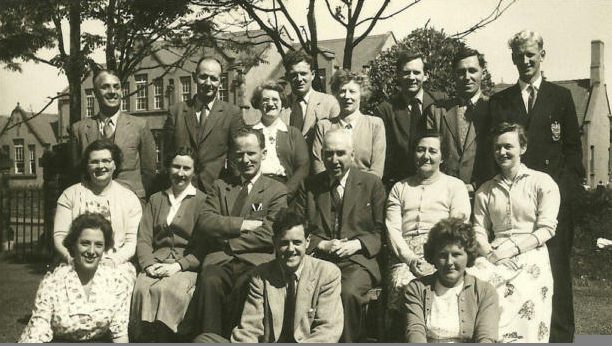 I would like to THANK all the Head Teachers and staff of the schools listed below VERY MUCH for their kindness, and willingness to help me during my research about their schools. THANK YOU also to all the people who allowed me to borrow and copy their photographs for inclusion on the site.
I would like to THANK all the Head Teachers and staff of the schools listed below VERY MUCH for their kindness, and willingness to help me during my research about their schools. THANK YOU also to all the people who allowed me to borrow and copy their photographs for inclusion on the site.
if you have any photographs or information you would like me to include about your school days Thank You
Please E-mail me (Ann) SBreeze95@aol.com

HOLYHEAD COUNTY SCHOOL was the very first school to become a secondary comprehensive in Great Britain. This happened in 1949. There were two main reasons why HOLYHEAD school was chosen. firstly the headmaster of the school at the time Mr J.M. Hughes was retiring, and he was replaced by a new headmaster who was interested in the development of comprehensive education. Secondly, St. Cybi central (modern) school and the county school adjoined one another so it was easy to bring about the amalgamation. Pupils attending the school would be from Holyhead and the surrounding smaller villages. Mr Lovett took up his new job in January. He’d previously taught at Vaynor and Penderyn school so his views about secondary education were well known, as were the educational principles in which he believed. These remained the core of his philosophy during his headmastership at HOLYHEAD, and showed itself time and again in his writing and lectures. This led him to be known as “the first apostle of the comprehensive movement”. In his opinion, for a comprehensive school to be successful it should serve a definite catchment area, and cater for ALL abilities and social background. The pupils should be 11 years of age and could enter the school without a previous examination (called the 11+ which was abolished in 1954). He did not believe that a child’s WHOLE FUTURE should be based on just one exam. He also believed that providing specialised education for the able pupils would be of benefit to them. It was possible to do this because of a large number of teachers at the school. He believed in giving all pupils of all abilities a chance to reach their full potential. Mr Lovett took the lead in the planning of the amalgamation of the grammar and modern school in co-operation with the Anglesey Education Committee, the School’s governing body and the teacher’s representatives. Great progress was made, and after just two years he reported “The school is rapidly approaching my concept of what a comprehensive school should be. On the grammar side, the facilities are good. The technical side is also rapidly developing and with the erection and equipping of the new engineering workshop the facilities or this type of education will be good. We have a large number of pupils of the modern school type and a real effort is being made to give them an education suitable to their aptitudes and abilities. Work of a far more practical nature must be introduced for these pupils and this demands further expansion in providing the requisite facilities and staff” Trefor Lovett was described as “the apostle of the doctrine of progressive differentiation” because of his belief “that a pupil’s progress should be extended to the maximum his natural rate and that the pupils could only be expected to select subjects after experience of the various alternatives”. Her Majesty’s Inspector of Schools said that Mr Lovett had brought considerable resourcefulness and single-mindedness to the foundation and growth of the school in its present form, a very clear idea of an objective and no little tenacity, energy and organising ability in the pursuit of this objective. New entrants were impressed with the school, with its overwhelming sense of order and discipline. They had a school uniform a school song, school motto, a powerful headmaster, and excellent teachers. Pupils moved from one classroom to another for different lessons. The subjects they studied included Biology, Chemistry, Physics, Choral Music, Woodwork, Art, Domestic Science for girls, Geometry and Algebra, Welsh, French and German, Geography and history, as well as Physical Education and seasonal games like football and cricket for boys, and hockey and rounders for girls. Every day pupils would meet for morning assembly. There was a “house” system, for in all, named after colours. Each house would compete against the others in annual events like the school Eisteddfod and sports days. By 1963 four other comprehensive schools had opened on Anglesey – in Amlwch, Beaumaris, Llangefni, and Menai Bridge. Each school competing again the other, especially in the annual County sports events. Each school would host in turn. HOLYHEAD county school always did well at these events winning many trophies. During my research for the County School section of this site, I came across other interesting facts and would like to share them with you:-1. Teachers always wore their black gowns during the school working day. 2. A school magazine was printed by Gees’ Press, Denbigh. It included historical pieces, a series on seabirds, and distinguished writers such as Megan Lloyd George also contributed. 3. Of the many teachers that have taught at the school, there are many fond memories of Mr S. Richardson (Mathematics), Miss Gilchrist (History), Miss Bullough (English), Mr Byrne (Physics), Miss E. Mary Thomas, Mr Eryl Hughes (Chemistry), Mr R. A. H. Bacon (PT), Mr H S Whaley (English). 4. School uniform has changed over the years, and have for the girls included white blouses, green gymslips and a green sash with green or white socks, and brown shoes. During the summer the girls wore green and white gingham dresses. 5. Boys were not allowed to wear long trousers until their fourth year!!!! 6. School Christmas Carol services were held at Hyfrydle Methodist Chapel in Thomas Street annually. 7. The construction of the school’s swimming pool under the gymnasiums was never finished – and is still there today! 8. Miss Bullough (teacher at the school) became a Senior Mistress. She taught English and had a marking system which was unique. This included marks such as B + + and By the mid to late 1960’s the school’s intake of pupils had risen sharply, to over 300 a year. Mr Len Roberts (a PT teacher and Head of the lower school in the 1970’s) recalls a small boy crying and in considerable distress in a cloakroom. The little boy said “Ma gas gen i’r diawl lle ‘ma” (I hate this place!!). He had been transferred from a very small rural school. This incident, however, touched Mr Roberts so much that it prompted a re-assessment in the school’s role in the transition to secondary school from the primary. It meant that Mr Roberts visited each primary school and spoke to the children prior to their transfer. He showed them slides of the school and answered their many and varied questions in order to put their minds at ease. In late 1960, ‘s the main County School building was demolished and new classrooms, offices and a library were built and later the main hall. The first entrants to the “New look” school on 1st September 1970 (I remember it WELL because I was amongst them”). There was a new “Playground” area nicknamed the QUAD. On the left of the quad attached to one of the walkway overhead covers was a cloud, and diagonal rods to represent rain, and a rain puddle all made out of aluminium. The school’s pupils were divided into 8 “houses and given badges with their house name and colour on. Each house had its own “hall” and canteen/kitchen. There were weekly competitions between the “houses” for the house whose pupils had gained the most COMMENDATIONS for excellent work. The pupils were delighted when teachers handed them back their newly marked books if they had a massive “C” next to their work above are the badges that were worn by the pupils of each “house”. Do you remember, or do you know of someone who used to wear one? In the 1980’s the school uniform was altered slightly to keep up with the times when woollen jumpers for both boys and girls were replaced by bottle green sweatshirts bearing the logo of the school. Into the year 2000 and the new Millennium, the school’s Headmistress was Mrs Chantrell. She was a popular and very respected Headmistress. Each year the school opens it’s door for parents’ evenings and very well attended shows in which the pupils take part. The uniform slightly changed again, as the new entrants in September 2000 wore a newly designed bottle green V neck woollen jumpers bearing the school logo. If you have any stories you would like to share, or photos you would like to add to the Holyhead County School section of this site, please E-mail me (Ann) at SBreeze95@aol.com

Back row
Unknown,unknown, Edward Gwynne Jones,unknown, Owen Richard Owen (my dad),unknown
Next row
Miss Lilibut Jones, Miss Cassie Jones
Next row
Miss Menna Jones (Lady Menna Cynan),
Miss DorothyRichie, Goronwy Williams (maybe) ,unknown (could be head of
Cybi?)
Miss G Owen,unknown
Seated
Unknown, unknown, Miss Edwina Hopkins.
Top row
OR Owen,Unknown, Edward Gwynne Jones, unknown
Middle row
Llew Jones, Lilibut Jones, Ann Edwards, Cassie Jones, Menna Jones, G Owen
Bottom row
Goronwy Williams, Avril Hughes, head? Miss Dorothy Richie unknown
